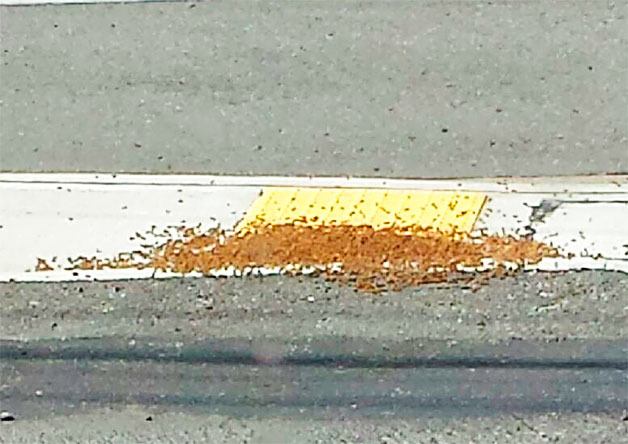Apparently, the Oak Harbor real estate market isn’t just heating up for humans.
A queen bee who needed some new digs for herself and a few thousand of her honey bee buddies caused a stir Sunday when her swarm took a pit stop near the intersection of Midway Boulevard and Highway 20.
A driver and a jogger both called 911 around 1:30 p.m. to report a swarm of honey bees clustering on the sidewalk near the Hot Shot Espresso stand, said Sgt. Bill Wilkie of the Oak Harbor Police Department.
“They covered the sidewalk and were lumped on top of each other,” Wilkie said.
Dispatchers dialed local bee experts to deal with the swarm while the city’s public works department arrived with signs to keep the area clear.
It’s not unusual to see swarms of honey bees this time of year.
Spring is swarming season, said Paul Neumiller, a local attorney and hobby apiarist. When the weather warms and buds swell, honey bees get busy — and not just with eating all that pollen.
“They lay eggs and they start thinking, ‘Uh-oh, we’re getting too big for our house,’ ” he said.
The queen bee takes half her entourage and buzzes off in search of new home.
When honey bees are hive-less, they don’t have a honey supper waiting for them after a hard day of zzzzing. The swarm alights on something — usually a tree branch — and gathers around the queen in one football-shaped, wriggling mass.
The queen isn’t the strongest of flyers and needs to rest. Meanwhile, the scout bees do recon for real estate.
The vast majority of honey bees are females. The small number of male drones get kicked out of the hive every fall and likely weren’t part of the swarm, Neumiller said.
Neumiller is part of a network of Whidbey Island apiary experts whom people call on to remove swarms. He didn’t remove this one. When he does remove a swarm, he dons a bee suit and then gets the queen bee into a cardboard box. If she’s on a tree branch, he’ll climb a ladder, gingerly cut loose the branch and place the roiling mass into the box.
“Hopefully, they’ll stay in there,” he said.
Once the queen is in the cardboard box, he’ll move the bees into a sturdier hive box. Some of the bees will leave the box, turn their rears outward and fan the air. They’re sending a pheromone message from the queen to all the stray bees in the air to let them know the location of their lady leader.
When the hive regroups and calms down after nightfall, he moves the hive to a permanent location.
Sunday, a few other local apiary experts showed up and got the queen placed into her temporary home.
Honey bees are docile and these ones didn’t reportedly sting anyone, Wilkie said.


